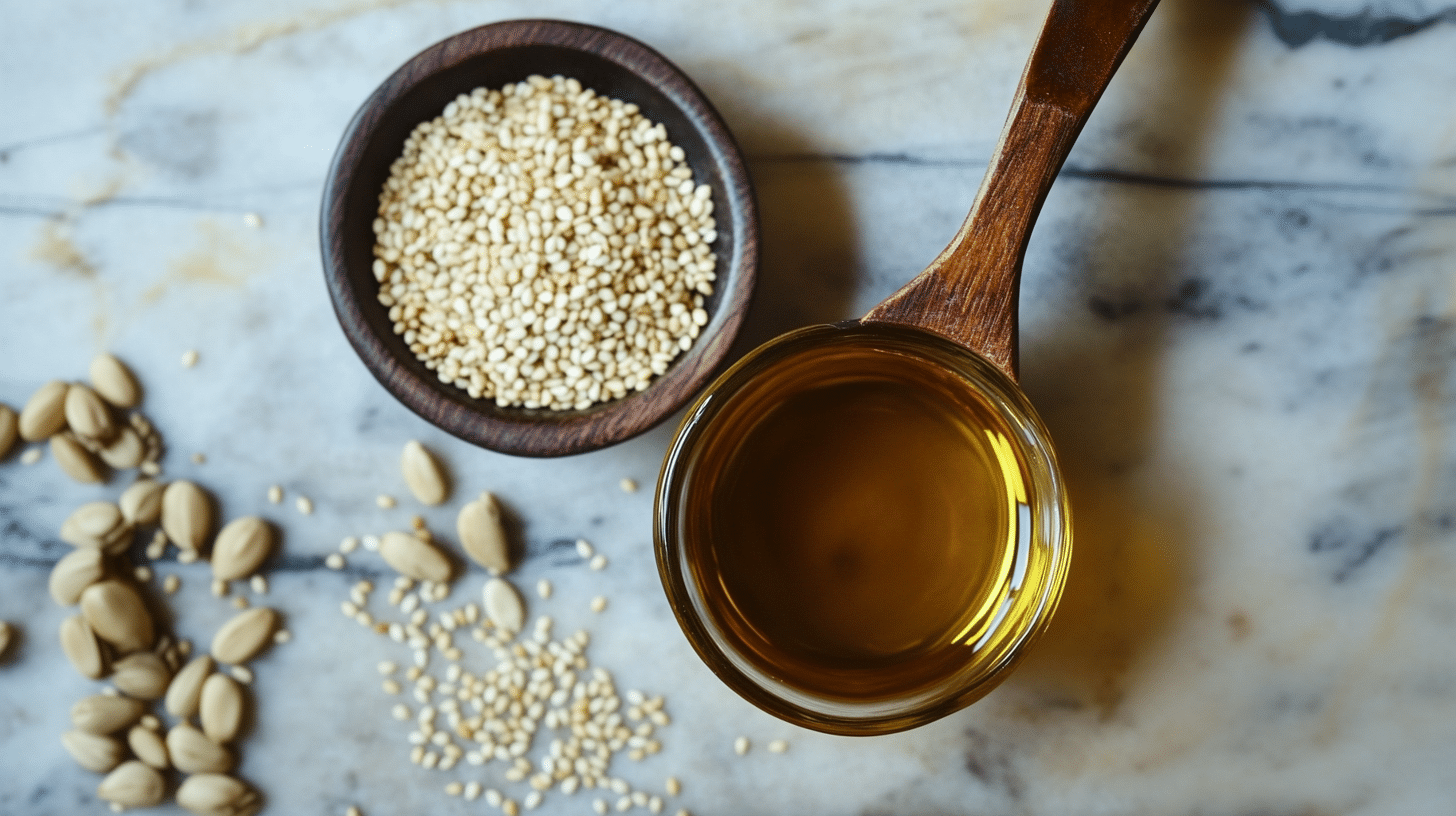Running out substitute for sesame oil can be a culinary hiccup, especially when preparing dishes that rely on its unique flavor. Whether you’re looking for a quick substitute for sesame oil or interested in crafting your own, this guide offers practical solutions and recipes to keep your meals flavorful
Understanding substitute for sesame oil
The Role of Sesame Oil in Cooking
Sesame oil, derived from sesame seeds, is a staple in many Asian cuisines. It comes in two primary forms: light (untoasted) and dark (toasted). Light sesame oil has a mild flavor and a high smoke point, making it suitable for sautéing and frying. In contrast, toasted sesame oil boasts a rich, nutty flavor, ideal for drizzling over finished dishes or incorporating into dressings and marinades.

Common Substitutes for Sesame Oil
When sesame oil isn’t available, several alternatives can mimic its flavor or function:
- Light substitute for sesame oil:
- Olive Oil: A versatile option with a mild flavor, suitable for various cooking methods.
- Avocado Oil: Known for its high smoke point and neutral taste, it’s excellent for frying and sautéing.
- Grapeseed Oil: A light, neutral oil that’s great for dressings and high-heat cooking.
- Toasted substitute for sesame oil:
- Toasted Walnut Oil: Offers a deep, nutty flavor, perfect for finishing dishes.
- Toasted Almond Oil: Provides a sweet, nutty essence, suitable for dressings and drizzling.
- Perilla Oil: Common in Korean cuisine, it has a robust, earthy flavor akin to toasted sesame oil.
Read this article for more details: Sesame Oil Substitute – Top Alternatives and DIY Recipes.
Crafting Homemade Sesame Oil
DIY Toasted Sesame Oil Recipe
Creating your own toasted sesame oil is straightforward and rewarding:
Ingredients:
- ¼ cup raw white sesame seeds
- 1 cup neutral oil (e.g., grapeseed or avocado oil)
Instructions:
- Toast the Seeds: Place sesame seeds in a pan over medium heat. Stir continuously for 12-15 minutes until they turn golden brown.
- Cool and Blend: Transfer the toasted seeds to a bowl to cool. Once cooled, blend them with the oil until smooth.
- Strain: Pour the mixture through a fine mesh sieve or cheesecloth into a jar, extracting as much oil as possible.
- Store: Keep the oil refrigerated in an airtight container for up to several months.
This homemade version captures the essence of toasted sesame oil, enhancing dishes like stir-fries and salads.
Quick Sesame Oil Infusion
For a faster alternative:
- Toast Sesame Seeds: Lightly toast 2 tablespoons of sesame seeds until golden.
- Combine with Oil: Mix the toasted seeds with ½ cup of neutral oil.
- Infuse: Let the mixture sit for a few hours or overnight to develop flavor.
- Strain and Store: Strain the oil and store it in a sealed container in the refrigerator.
This method provides a quick sesame-infused oil suitable for various culinary applications.
Read this article: Quick Guide: Sub Sesame Oil Without Losing Flavor
Incorporating substitute for sesame oil in Recipes
Stir-Fries and Sautéed Dishes
When preparing stir-fries, avocado oil serves as an excellent base due to its high smoke point. To replicate the nutty finish of toasted sesame oil, drizzle a small amount of toasted walnut or almond oil over the dish just before serving.
Salads and Dressings
For salad dressings, combining olive oil with a touch of perilla oil can emulate the depth of sesame oil. Alternatively, a blend of grapeseed oil and a few drops of toasted sesame oil substitute can achieve a similar effect.
Additional Tips and Considerations
Allergy-Friendly Options
For those with sesame allergies, perilla oil can be a suitable alternative, offering a comparable flavor profile. However, always consult with a healthcare professional before introducing new ingredients.
Storage and Shelf Life
Homemade sesame oil should be stored in the refrigerator to maintain freshness and prevent rancidity. Always use clean utensils when handling to avoid contamination.
FAQs
Q1: What can I use as a substitute for sesame oil in recipes?
Light sesame oil can be replaced with neutral oils like olive, avocado, or grapeseed oil. For toasted sesame oil, consider using toasted walnut or almond oil, or perilla oil for a similar flavor.
Q2: How do I make homemade sesame oil?
Toast ¼ cup of sesame seeds until golden, blend with 1 cup of neutral oil, strain, and store in the refrigerator. This creates a flavorful sesame-infused oil suitable for various dishes.
Q3: Is perilla oil a good substitute for sesame oil?
Yes, perilla oil offers a nutty flavor similar to toasted sesame oil and is commonly used in Korean cuisine. It’s a suitable substitute, especially for those avoiding sesame.
Q4: How long does homemade sesame oil last?
When stored properly in the refrigerator, homemade sesame oil can last for several months. Always check for any signs of spoilage before use.
Conclusion
While sesame oil imparts a distinct flavor to dishes, various substitutes and homemade options can effectively replicate its essence. By understanding the role of sesame oil and exploring substitute for sesame oil, you can continue to create delicious meals without compromise.
Ressources:
1- webmd: Sesame Oil: Is It Good for You?
2- healthline: 10 Science-Backed Benefits of Sesame Oil
